
Are you looking to create a winning digital marketing strategy but don't know where to start? Look no further! This article will show you how to create a digital marketing plan to help you achieve your business goals.
First, let's look at a digital marketing strategy and why it's essential. A digital marketing strategy is a plan of action businesses use to promote their products or services online. This strategy should be aligned with the overall business goals. For example, if your goal is to increase brand awareness, your digital marketing strategy should focus on creating informative blog posts or running social media ads.
Once you know your goal, developing your digital marketing campaign is time. To do this, you'll need to identify your target audience and determine where they spend their time online. Once you know your target audience and where they're hanging out, you can start creating content that will appeal to them. For example, if you're targeting millennials, you might want to create social media posts that are funny and relatable.
Once you have your target audience and content strategy figured out, it's time to start promoting your product or service. There are several ways to do this, but some of the most effective include pay-per-click advertising, search engine optimization, and email marketing.
Finally, don't forget about customer service! This is especially important if you're selling products or services online. Make sure you have a solid customer service strategy in place to quickly and efficiently resolve any issues that arise.
Let's examine these steps in detail.
The Digital Marketing Strategy That Works
What is a digital marketing strategy? A digital marketing strategy is a plan of action businesses use to promote their products or services online. This strategy should be aligned with the overall business goals. For example, if your goal is to increase brand awareness, your digital marketing strategy should focus on creating informative blog posts or running social media ads.
Why is a digital marketing strategy necessary? A digital marketing strategy is essential because it helps businesses achieve their online marketing goals. Without a plan, businesses can easily get lost in the sea of online competition. A well-thought-out digital marketing strategy will help companies to stand out from the crowd, attract more leads, and convert more sales.
How do you create a digital marketing strategy? Creating a digital marketing strategy can seem daunting, but it doesn't have to be. Here's a step-by-step guide to creating a winning digital marketing strategy:
Define Your Goal
Before you can start planning your digital marketing strategy, you need to know your goal. For example, are you looking to increase brand awareness, generate leads, or drive sales? Once you know what you want to achieve, you can start developing a plan.
For example, if your goal is to increase brand awareness, you might want to focus on SEO and content marketing. You can optimize your website for specific keywords and produce blog posts and articles to help raise your profile. In addition, you might want to invest in PPC or social media advertising to generate leads. And if you're hoping to drive sales, eCommerce SEO and email marketing could be your best bet.
No matter what your goal is, defining it is the first step in creating a successful digital marketing strategy.
Identify Your Target Audience
The next step is to identify your target audience. Who are you trying to reach with your digital marketing campaigns? Once you know your target audience, you can start figuring out where they spend their time online.
For example, do they spend time on social media sites like Facebook or Twitter? Or do they prefer to read blogs or watch videos? Knowing where your target audience hangs out will help you choose the right platform to promote your product or service.
For example, if you're selling a new cooking gadget, you might want to focus your efforts on food bloggers and YouTube cooking channels. If you're promoting a new app, on the other hand, you might want to focus on social media platforms like Facebook and Twitter. Knowing where your target audience spends their time online can promote your product or service more effectively.
Create Compelling Content
Once you know your target audience and where they spend their time online, it's time to start creating content that will appeal to them. This content should be informative, engaging, and relevant to your target audience. For example, if you're targeting millennials, you might want to create social media posts that are funny and relatable.
Similarly, if you're targeting baby boomers, you might want to create blog posts that offer advice on retirement planning or health and wellness. By creating compelling content that resonates with your target audience, you'll be more likely to capture their attention and build a loyal following.
Promote Your Product or Service
There are several effective ways to promote your product or service. Pay-per-click advertising, for example, is a great way to reach your target audience directly. Search engine optimization can also be highly effective, helping you get potential customers searching for products or services like yours.
Email marketing is another excellent option, allowing you to connect with potential customers and build long-term relationships. Whatever promotional strategy you choose, ensure it aligns with your overall content strategy. This will help you get the most out of your marketing efforts and ensure that your target audience sees the right message.
Provide Excellent Customer Service
Providing excellent customer service is essential for any business. You can do a few key things to ensure your customers are always happy. First, always be available to answer questions or deal with problems. This means having a customer service team that is responsive and easy to reach.
Second, ensure you have a system for handling returns and refunds quickly and efficiently. And third, always keep your promises. If you say you will do something, make sure you follow through. Excellent customer service will keep your customers coming back for more.
To see better results from your digital marketing campaigns, it's essential to focus on all aspects of the customer experience. By defining your goal, identifying your target audience, creating compelling content, promoting your product or service, and providing excellent customer service, you can create an effective digital marketing strategy that produces accurate results. So, are you ready to get started? Our join digital marketing course will help you put these principles into practice and achieve success with your online marketing efforts.

Frequently Asked Questions
What are the first steps in creating a successful digital marketing campaign?
Understanding your audience is the first step in creating a successful digital marketing campaign. Who are you trying to reach? What are their needs and wants? What kinds of content will resonate with them?
Once you know your target audience, you can begin to create content that engages and interests them.
Another critical step is to set realistic goals for your campaign. What do you hope to achieve?
For example, are you looking to increase brand awareness, generate leads, or drive sales? Once you know what you want to accomplish, you can start to develop a strategy for how to reach your goals best. Finally, don't forget to measure the results of your campaign so that you can track your progress and make necessary adjustments along the way. By following these steps, you'll be well on your way to developing a successful digital marketing campaign.

What are some common mistakes businesses make in digital marketing?
Many digital marketing channels are available to businesses, and each has its strengths and weaknesses. As a result, it can be difficult for companies to know where to focus their efforts. One common mistake is trying to be active on every channel without taking the time to understand each platform's different audiences and goals.
Another mistake is to invest heavily in one channel without diversifying their approach. This can lead to problems if the channel underperforms or changes unexpectedly.
A final mistake that businesses often make is failing to track and measure their results. Without this data, it is difficult to tell what is working and what needs to be improved. By avoiding these mistakes, businesses can set themselves up for success in the digital marketing landscape.

How can you measure the success of a digital marketing campaign?
There are a few different ways to measure the success of a digital marketing campaign. One way is to track the number of leads or sales generated from the campaign. Another way is to track the number of people who view or click on your content. Finally, you can track engagement metrics such as likes, shares, and comments.
By monitoring these metrics, you can get a good idea of how well your campaign is performing and make necessary adjustments along the way.
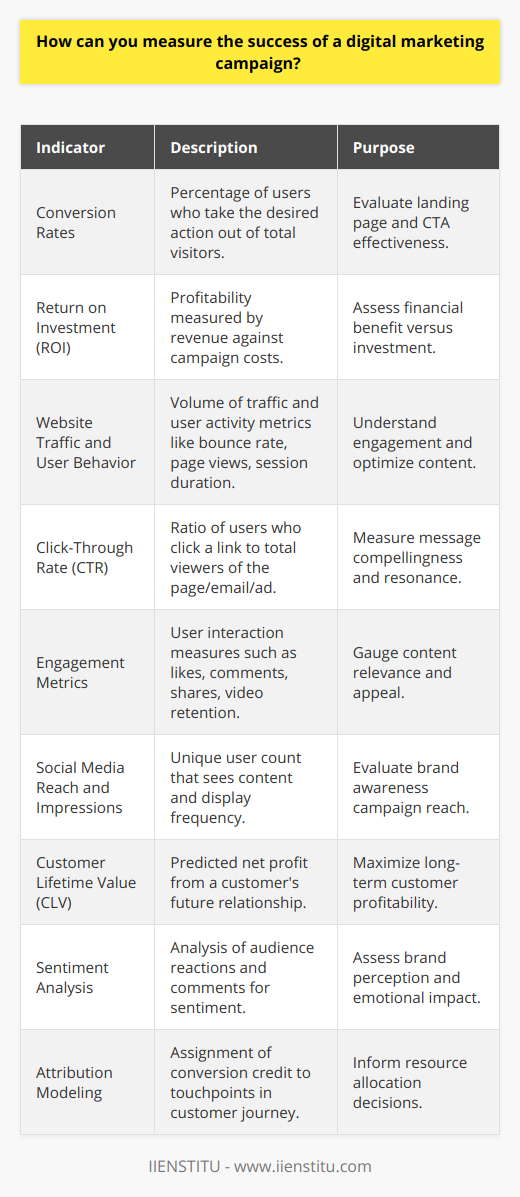
What are some common goals for businesses when it comes to digital marketing?
Businesses can set many different goals for themselves when it comes to digital marketing. Some standard plans include increasing brand awareness, generating leads, driving sales, and improving customer satisfaction. By setting realistic and achievable goals, businesses can better measure the success of their campaigns and make necessary adjustments along the way.
What are some common digital marketing channels that businesses use?
There are many different digital marketing channels available to businesses. Some standard tracks include email marketing, social media marketing, content marketing, pay-per-click advertising, and search engine optimization. By understanding the strengths and weaknesses of each channel, businesses can choose the best channels for their particular goals.
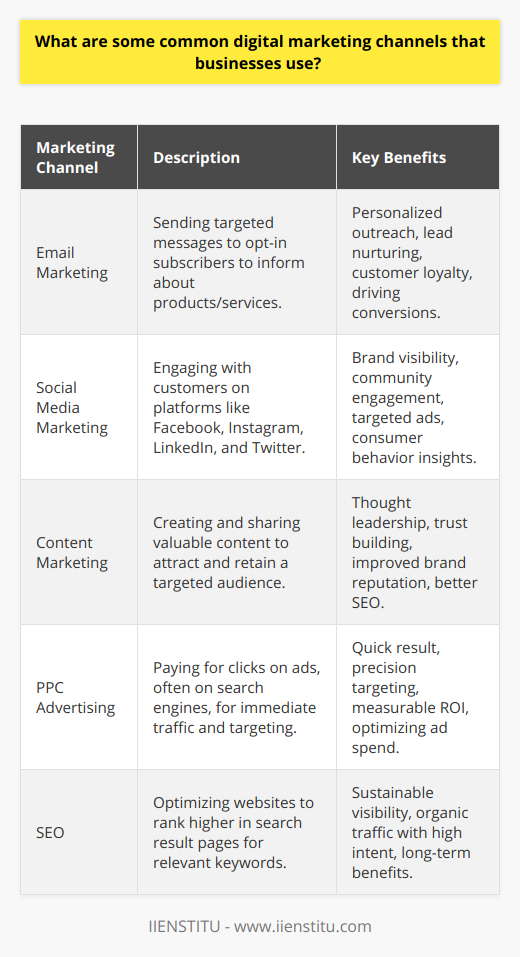
What are some common ways to generate leads?
There are many ways to generate leads; the best method will vary depending on your business goals. Some standard lead generation methods include developing compelling content, running pay-per-click ads, and optimizing your website for search engines. By combining these methods, you can generate a steady stream of leads that you can nurture into customers.

How do you create a winning digital marketing strategy?
Understanding the Target Audience
Creating a winning digital marketing strategy begins with understanding the target audience. By researching and analyzing their preferences, behaviors, demographics, and pain points, marketers can develop a comprehensive buyer persona. This information enables businesses to tailor their marketing initiatives to meet the specific needs of their prospective customers effectively.
Defining Clear Objectives
Next, a successful digital marketing strategy requires clear objectives that align with the company's overall business goals. These objectives, often referred to as Key Performance Indicators (KPIs), provide a benchmark for measuring the success of marketing efforts. Setting SMART (Specific, Measurable, Achievable, Realistic, and Timely) goals ensures that digital marketing campaigns remain focused and provide tangible outcomes that contribute to the organization's success.
Choosing the Right Channels
Once the target audience and objectives are established, selecting the appropriate digital channels is crucial for delivering the desired results. Common digital marketing channels include search engine optimization (SEO), pay-per-click advertising (PPC), social media marketing, and email marketing. The choice of channels should be based on their relevancy to the target audience and their potential to achieve the determined KPIs.
Creating Engaging Content
Developing engaging, valuable, and relevant content is the backbone of a winning digital marketing strategy. This content must address the pain points and interests of the target audience while showcasing the unique selling proposition of the brand. Different content formats, such as blog posts, infographics, videos, and podcasts, should be utilized to cater to the preferences of the diverse audience segments.
Implementing Data-Driven Tactics
A successful digital marketing strategy must continuously evolve by incorporating data-driven tactics. By analyzing and interpreting data from various marketing channels, businesses can identify trends, monitor performance, and make data-informed decisions for campaign optimization. Employing tools like Google Analytics, social media insights, and email marketing metrics helps track these metrics effectively.
Fostering Collaboration and Integration
Finally, fostering collaboration and integration among various marketing channels reinforces a cohesive brand message and enhances the overall impact of the digital marketing strategy. With all channels working in harmony, businesses can develop a synergistic, holistic approach that delivers a seamless, consistent experience to the target audience, increasing the likelihood of achieving their digital marketing goals.
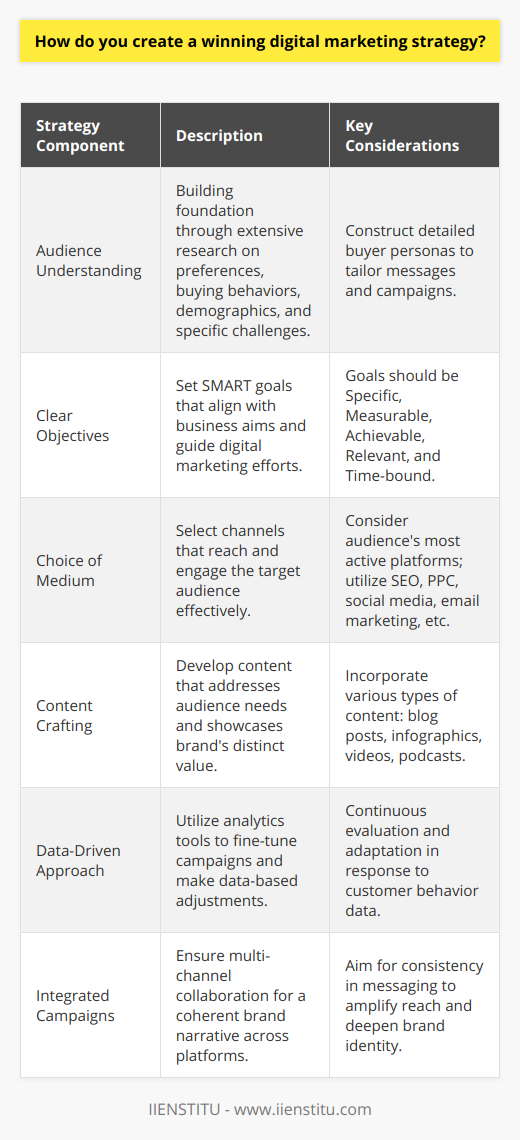
What is the 70 30 rule in digital marketing?
Understanding the 70-30 Rule
The 70-30 rule in digital marketing refers to a content strategy guideline that aims to optimize audience engagement and create a balanced mix of promotional and valuable information. According to this rule, 70% of the content shared on digital platforms should focus on delivering value to the audience, while the remaining 30% should be geared toward promoting the brand or organization.
Maintaining Value-Driven Content
Value-driven content prioritizes addressing the needs and interests of the target audience. This can include educational articles, how-to guides, industry news updates, or expert opinions. The primary goal is to provide useful, relevant, and engaging information that addresses the concerns and motivations of the audience. Adhering to the 70% of value-driven content ensures that customers perceive the brand as a helpful and reliable resource, which can ultimately lead to higher levels of trust and loyalty.
Implementing Promotional Content
On the other hand, the 30% of promotional content emphasizes showcasing the brand's products or services, special offers, or events. This type of content should be implemented in a way that highlights the benefits and competitive advantages offered by the brand, without appearing overly sales-driven or intrusive. Balancing the proportion of promotional content helps prevent the audience from becoming disengaged or developing a negative perception of the brand due to excessive self-promotion.
Adapting to Audience Feedback
The 70-30 rule serves as a starting point for many digital marketing campaigns, but its flexibility allows marketers to modify the ratio, depending on the specific goals, target audience, and performance metrics of the campaign. Evaluating the engagement and feedback from the audience can provide valuable insights, helping marketers identify which types of content resonate the most with their target demographic. These insights can then be used to adjust the content mix, ensuring that the marketing strategy remains responsive and in line with audience preferences.
In conclusion, the 70-30 rule in digital marketing presents a strategic framework for creating an effective content mix by balancing value-driven and promotional content. By adhering to this guideline, marketers can create a mutually beneficial relationship with their audience, fostering trust, loyalty, and lasting customer connections while promoting their brand and offerings in an appealing manner.
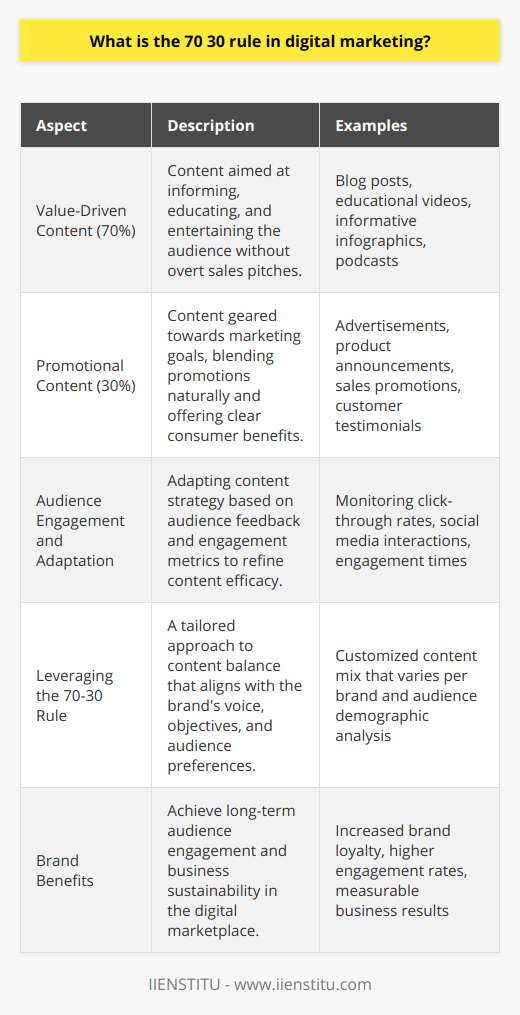
How long does it take to create a comprehensive digital marketing strategy?
Timeframe for Developing a Comprehensive Digital Marketing Strategy
Factors Influencing the Duration
The development of a comprehensive digital marketing strategy varies in length as it depends on several factors. Firstly, the size and complexity of the business play a significant role in determining the duration. A small business with limited services may require a shorter period, while a larger organization with multiple products and target markets may take longer.
Establishing Clear Objectives and Goals
Another significant factor is the clarity of objectives and goals. A well-defined digital marketing strategy must have clear, measurable, and attainable goals. Therefore, an extensive initial analysis of the business, its strengths, weaknesses, opportunities, and threats (SWOT) is crucial. It ensures the formulation of realistic and targeted goals, thus affecting the overall time taken.
Research and Customization
A comprehensive digital marketing strategy must be customized to the business's unique needs and audience. In-depth research and analysis revolving around the target audience, competitors, and industry trends are time-consuming but essential. This step allows the marketer to create a tailor-made action plan that resonates with both the business's objectives and the target market's preferences.
Integration with Traditional Marketing Strategies
Digital marketing does not function in isolation; it must be integrated with traditional marketing channels. This process may require additional time to develop a cohesive approach that blends the digital and traditional aspects effectively. Collaboration among marketing teams and departments is crucial to ensure smooth alignment that benefits the business and enhances brand consistency.
Continuous Revision and Adaptation
It is vital to note that digital marketing strategies must be flexible, as the digital landscape is ever-evolving. Regular monitoring and adjustment of the strategy may lead to better results and improved customer engagement. Although this process adds to the duration, it warrants the investment of time and resources, as it ensures that the strategy remains current and effective.
In conclusion, the development of a comprehensive digital marketing strategy is an ongoing process with no fixed duration. The size of the business, clarity of goals, need for research, integration with traditional strategies, and continuous adaptation all affect the time taken to create an effective digital marketing strategy. Understanding these factors and dedicating resources to each step can lead to a well-rounded and successful digital marketing approach.
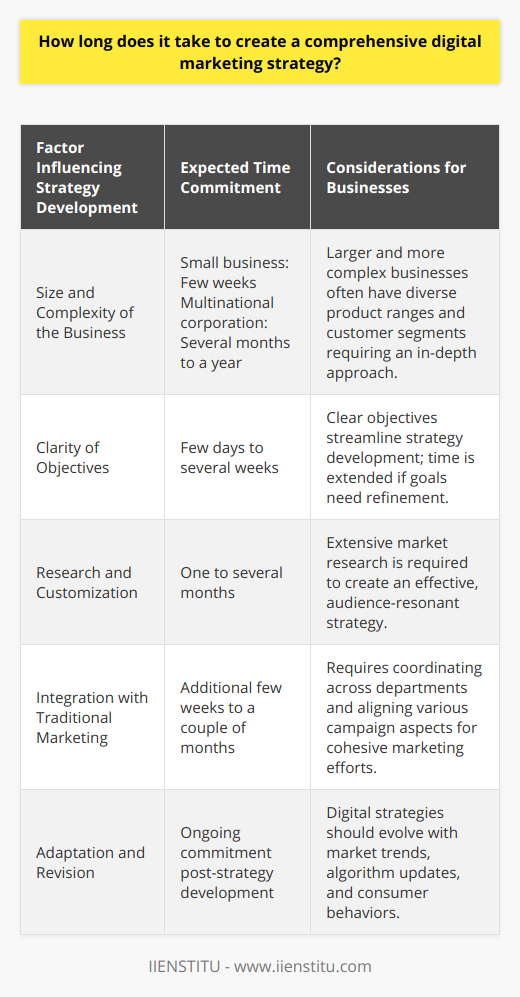
How can the 70 30 rule in digital marketing be effectively implemented for optimal results?
Understanding the 70-30 Rule
The 70-30 rule in digital marketing refers to the practice of allocating 70% of a brand's content to be informative, entertaining, or educational while the remaining 30% is promotional in nature. By following this ratio, businesses aim to foster customer engagement, trust, and loyalty. To implement this strategy effectively, marketers must identify the right balance and content type to cater to their audience's needs while prioritizing valuable and relevant information.
Developing Informative Content
Creating informative and engaging content constitutes the largest portion of the 70-30 rule. This should primarily focus on educating, entertaining, or engaging with the audience, without overtly promoting the company's products or services. For instance, blog posts, eBooks, infographics, and videos addressing trending topics or industry news are recommended. Additionally, sharing curated content from respected sources can help a brand become a thought leader in its domain, thus enhancing trust and credibility.
Crafting Promotional Content
Promotional content constitutes the remaining 30% of the 70-30 rule in digital marketing. This content explicitly features the company's products or services, highlighting their unique selling points and entailing a clear call-to-action (CTA). Examples of promotional content include special offers, product announcements, discounts, or testimonials. For optimal results, brands should ensure that promotional content is strategically integrated with non-promotional content to create a seamless user experience.
Analyzing Content Performance
Regularly monitoring and analyzing content performance helps marketers to make informed decisions and effectively implement the 70-30 rule. By utilizing tools such as Google Analytics and social media analytics, brands can track key performance indicators (KPIs) that reveal the effectiveness of their content strategy. Insights derived from this data can identify successful content types and topics, allowing businesses to optimize their strategy and maintain the appropriate balance between informative and promotional content.
In conclusion, the key to effectively implementing the 70-30 rule in digital marketing lies in striking the right balance between informative and promotional content. By focusing on delivering value and engaging with the audience through relevant and valuable information, brands can establish credibility and trust. Meanwhile, integrating timely promotional content can drive desired customer actions. Ultimately, monitoring and analyzing content performance enables businesses to optimize their marketing strategy for optimal results.
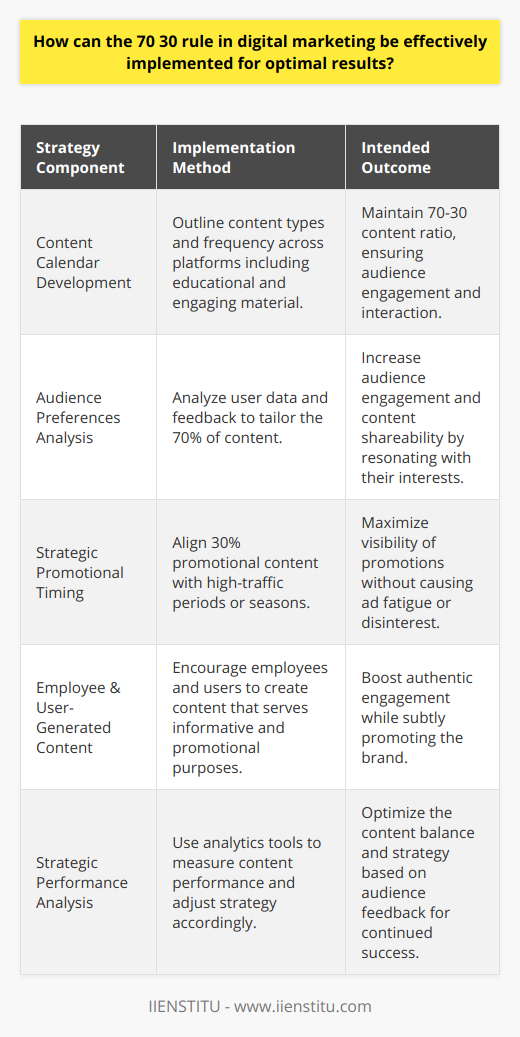
What are the essential components to include when creating a digital marketing strategy for beginners in 10 steps?
Understanding the Components
To create an effective digital marketing strategy for beginners, it is crucial to understand the essential elements that contribute to the success of such a plan. Discussed below are ten key components to consider when designing a beginner's digital marketing strategy.
Set Clear Goals
Establishing specific, measurable, achievable, relevant, and time-bound (SMART) goals is the initial step, as it provides direction and a roadmap for the overall strategy.
Define Target Audience
Identifying the target audience, including their demographics, interests, and preferences, will ensure the creation of tailored content and marketing messages that resonate with them.
Create Buyer Personas
Developing detailed buyer personas based on the target audience will assist in understanding their needs, pain points, and decision-making factors, enabling the development of targeted campaigns.
Research Competitors
Analyzing competitor strategies can provide valuable insights and help identify potential opportunities or areas of improvement within the market.
Select Appropriate Platforms
Choosing the right digital marketing channels, such as social media platforms, email marketing, and pay-per-click (PPC) advertising, will optimize the reach of the marketing efforts and maximize returns.
Develop Engaging Content
Creating engaging, relevant, and high-quality content is vital in attracting and retaining the target audience's interest, bolstering brand reputation, and improving search engine rankings.
Optimize for Search Engines
Implementing search engine optimization (SEO) techniques, such as using relevant keywords and generating backlinks, will enhance online visibility and increase the likelihood of attracting organic traffic.
Utilize Email Marketing
Employing email marketing enables the nurturing of leads, consistent communication with the target audience, and the promotion of products or services through tailored and personalized messaging.
Monitor and Analyze Performance
Regularly tracking and evaluating the performance of digital marketing efforts by using tools such as Google Analytics will provide insights to make informed decisions and optimize the strategy for better results.
Be Agile and Adaptive
Maintaining a flexible approach and being open to adjusting the strategy based on data-driven insights and changing market conditions will ensure long-term success in the ever-evolving digital marketing landscape.

Can you provide a practical example of creating a digital marketing strategy that has led to a successful campaign?
Practical Example of Digital Marketing Strategy
Overview of the Campaign
A successful digital marketing strategy can be exemplified through the 'Share a Coke' campaign by Coca-Cola. Launched in 2011, this integrated marketing campaign allowed customers to personalize their own coke bottles with their names, eventually leading to increased brand engagement and sales growth (Coca-Cola Journey, 2014).
Defining Campaign Objectives
Primary objectives of this campaign were to strengthen customer relationships, improve brand sentiment, and increase sales. These objectives guided the subsequent planning and execution of marketing initiatives.
Identifying Target Audience
The campaign focused on millennials, as data suggested that brand loyalty among them was lower than older generations. Consequently, Coca-Cola sought to rejuvenate its connection with this demographic by crafting a personalized, shareable experience.
Selecting Marketing Channels
To reach a wider audience, Coca-Cola incorporated various digital marketing channels in the campaign. These included social media platforms, supported by email marketing, content marketing, and mobile marketing strategies.
Developing Engaging Content
Coca-Cola created engaging and user-generated content by encouraging people to share their personalized coke bottles on social media platforms using the hashtag #ShareACoke. This strategy made the brand more relatable and allowed customers to interact with the company in a fun and exciting way.
Personalization and Customization
By providing an option to personalize bottles, the company appealed to the self-expressive nature of millennials. The customization also drove brand attachment, as customers felt more connected with the product they co-created.
Tracking and Measuring Success
The campaign's success was measured using various Key Performance Indicators (KPIs), such as user-generated content, social media engagement, and sales figures. Ultimately, the campaign led to 25 million Facebook and Twitter users engaging with the company, and a 2% increase in worldwide sales (Moye, 2015).
Adapting the Campaign
After assessing initial success, the campaign expanded to more than 80 countries, with local adaptations based on cultural insights. Iterative adjustments continued to evolve and optimize the overall strategy.
Conclusion
The 'Share a Coke' campaign illustrates the successful execution of a digital marketing strategy that taps into consumer emotions and sense of identity. By implementing a well-defined campaign objective, target audience segmentation, and incorporating multiple marketing channels, Coca-Cola achieved significant success in fostering brand engagement and increasing sales.
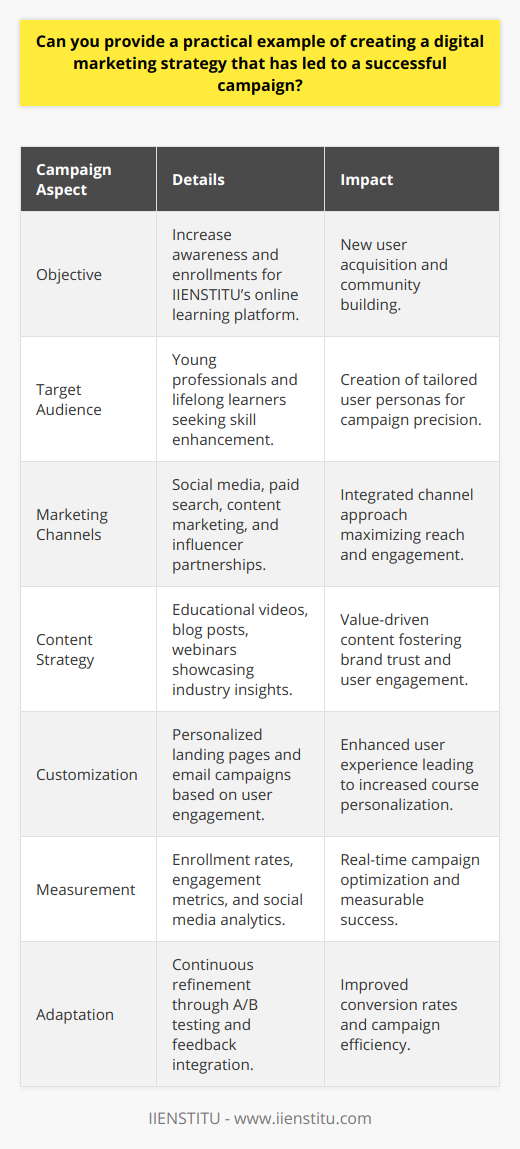
How do you create a winning marketing strategy that ensures a strong online presence for your business?
Understanding Target Audience
To create a winning marketing strategy that ensures a strong online presence for your business, it is essential to begin with a comprehensive understanding of your target audience. Analyzing demographic and psychographic factors, such as age, gender, location, interests, and shopping habits, can help tailor online marketing efforts to appeal to the specific needs and preferences of your customers.
Setting Measurable Goals
Next, determining clear and measurable goals for your marketing campaign will provide a benchmark to gauge success and enable informed adjustments when necessary. Examples of measurable goals include increasing website traffic, enhancing brand awareness, generating leads, and driving conversions. Make sure these goals complement your business objectives and are achievable with the available resources.
Developing Engaging Content
The creation of high-quality, engaging, and relevant content is crucial in attracting and retaining online audiences. Content should align with your brand identity and convey your unique value proposition while addressing the needs of your target audience. This could involve generating informative articles, creating visually appealing graphic designs, or producing captivating videos that showcase your products or services.
Optimizing for Search Engines
Ensuring your digital assets are search engine optimized (SEO) will increase your online visibility and improve the organic reach of your marketing efforts. Implementing a robust SEO strategy involves optimizing website elements (such as meta tags, headings, and keywords) and creating valuable, shareable content that attracts backlinks. Regularly monitoring and adjusting your SEO practices can help maintain high search rankings and drive consistent traffic to your website.
Leveraging Social Media
Using social media platforms effectively, such as Facebook, Instagram, Twitter, and LinkedIn, can amplify your marketing reach and enhance engagement with your target audience. Identifying the best channels for your industry, consistently posting relevant and enticing content, and interacting with followers can drive brand loyalty and foster online communities around your business.
Utilizing Paid Advertising
Incorporating paid advertising, such as Google Ads or sponsored social media posts, can complement your organic efforts to increase online visibility and reach a wider audience. Defining clear targeting parameters, setting appropriate budgets, and monitoring the performance of your ads can optimize results and ensure a positive return on investment.
Measuring and Analyzing Results
Finally, continually analyzing the outcomes of your marketing initiatives is crucial to determine their effectiveness and inform future adjustments. Employing analytic tools, such as Google Analytics or social media insights, can provide valuable data on key performance indicators, such as user engagement, website traffic, and conversion rates. By reviewing these metrics, businesses can refine their marketing strategies and achieve a strong online presence that drives growth and success.
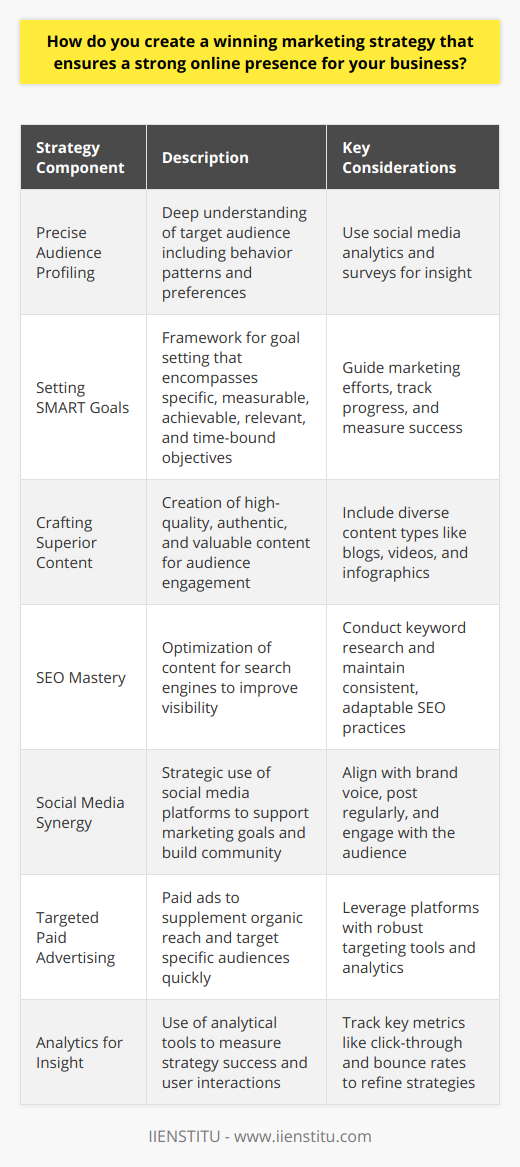
What are the key differences between traditional marketing strategies and digital marketing strategies, and how can they be combined effectively?
**Key Differences Between Strategies**
Traditional marketing strategies encompass techniques such as print advertising, door-to-door sales, billboards, television, and radio shows. On the contrary, digital marketing strategies involve search engine optimization, social media platforms, email marketing, and content marketing. While traditional marketing is characterized by one-way communication and limited audience targeting, digital marketing offers interactive user engagement and precise audience targeting.
**Complementing the Strategies**
Combining traditional and digital marketing strategies effectively involves identifying the strengths and limitations of each strategy. For instance, a billboard advertisement can create awareness and drive potential customers to the website, where they can learn more about the products or services on offer. In this scenario, the traditional marketing method serves as a connector between the digital platform and the target audience. Combining these strategies can also bring credibility to the brand, as being present in both traditional and digital spaces indicates stability and reliability.
**Enhancing Integration**
To integrate traditional and digital marketing strategies effectively, companies should set specific and measurable goals for each campaign. This will help in identifying the key performance indicators (KPIs) and analyze the success of each marketing approach. Marketers should also carefully monitor and compare the results of their combined efforts to optimize their strategies and allocate resources accordingly. In addition, using marketing tools such as marketing automation software and customer relationship management (CRM) systems can help integrate data from both traditional and digital campaigns, leading to deeper insights and better decision-making.
**Conclusion**
In summary, recognizing the key differences between traditional and digital marketing strategies can help business owners and marketers combine these approaches effectively. By leveraging the strengths of each strategy and monitoring the outcomes, companies can enhance their marketing efforts and ultimately achieve their objectives. Utilizing technology and data integration is crucial in this process, as it facilitates a comprehensive overview of the marketing landscape and offers valuable insights into customer behavior and preferences.
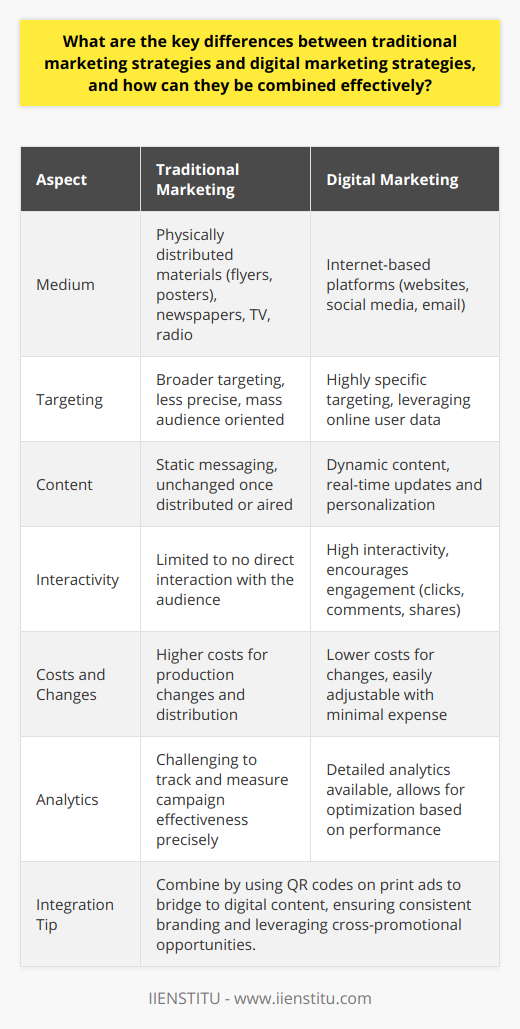
How do you create a digital marketing strategy example that effectively targets different audience segments and meets specific business objectives?
Understanding the Target Audience
To create a digital marketing strategy that effectively targets different audience segments and meets specific business objectives, the first step is understanding the target audience. This entails creating detailed buyer personas that encompass demographic information, preferences, behavior patterns, and consumer motivation.
Defining Clear Objectives
Once the target audience is understood, the next step is defining clear business objectives tied to the digital marketing strategy. These objectives should be specific, measurable, achievable, relevant, and time-bound (SMART), enabling tracking of progress and adjustment of tactics as necessary.
Content Creation and Distribution
With a foundation in place, it is crucial to develop and distribute content tailored to each audience segment. Strategic content creation should resonate with the target audience, serving their needs and interests while maintaining brand consistency. The content should also be engaging and easy to share across various digital platforms to maximize reach and exposure.
Developing a Multichannel Approach
An effective digital marketing strategy also demands a multichannel approach, leveraging several platforms to reach the target audience. Utilizing platforms such as social media, email marketing, and search engine optimization (SEO) ensures audience segmentation and optimizes touchpoints to increase conversion rates and achieve the intended business objectives.
Data-Driven Decision Making
Utilizing data collected from analytics tools is essential for informed decision making and optimizing overall digital marketing efforts. With insights into user behavior, preferences, and conversion paths, it becomes possible to fine-tune strategies to better align with each audience segment and achieve desired business objectives.
Iterative Optimization
Implementing a continuous improvement model allows for iterative optimization of digital marketing strategies. By consistently monitoring and analyzing key performance indicators (KPIs), it is possible to identify areas for improvement or adjustment and iteratively refine tactics based on real-time results.
In conclusion, creating a digital marketing strategy that effectively targets different audience segments and meets specific business objectives requires a comprehensive understanding of the target audience, clear objectives, tailored content, a multichannel approach, data-driven decision making, and continuous optimization. This approach ultimately enables businesses to connect with their audiences in a meaningful way while achieving desired results.
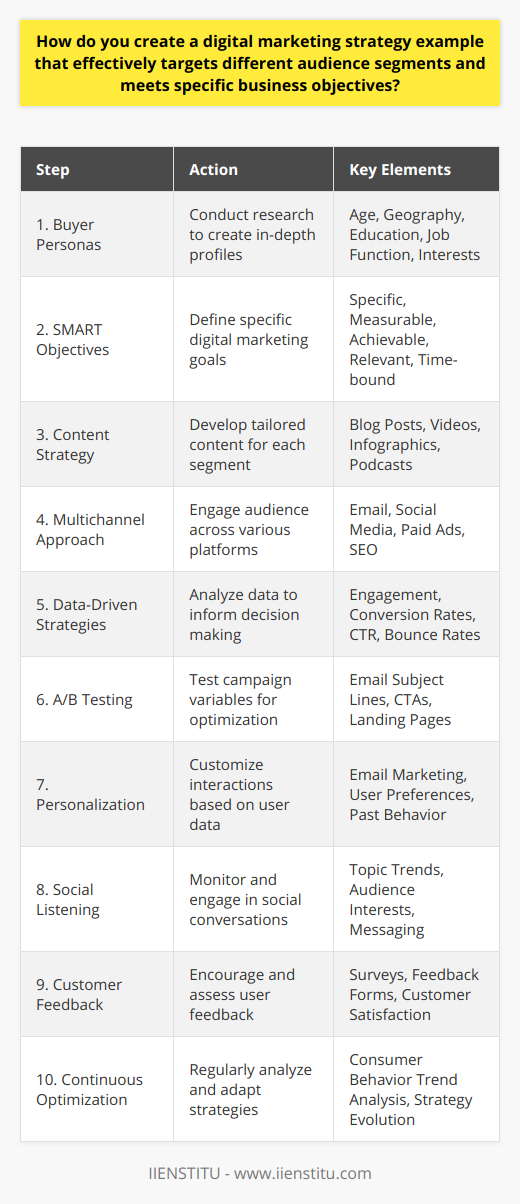
What are the five stages of planning a digital marketing strategy?
Understanding the Digital Marketing Strategy Planning Process
Planning a digital marketing strategy involves five critical stages.
Stage 1: Setting Strategic Goals
The first stage involves setting strategic goals. These goals should align with the overall objectives of the business, be specific, measurable, achievable, relevant, and timely (SMART).
Stage 2: Defining the Target Audience
The second stage is defining the target audience. Marketers should understand their audience's demographics, behaviors, needs, and preferences. It is essential to create buyer personas to hone in on what motivates customer action.
Stage 3: Analyzing the Competition
Thirdly, one must analyze the competition. Understanding competitors’ strategies, strengths, and weaknesses can guide the formulation of unique propositions and tactics that will propel businesses ahead.
Stage 4: Selecting Appropriate Digital Marketing Channels
The fourth stage involves selecting appropriate digital marketing channels. The choice relies on the business model, budget restrictions, and the preferences of the target audience. These might include social media, email marketing, content marketing, or search engine optimization.
Stage 5: Develop and Implement the Digital Marketing Plan
The final stage is to develop and implement the digital marketing plan. This encompasses designing individual campaigns for each channel, determining metrics to track success, and setting up tools for monitoring and evaluation.
By following these stages of planning, businesses can create a digital marketing strategy that aligns with their goals, targets the correct audience, considers the competitive landscape, utilizes the most effective channels, and has a clear plan of action. This streamlines the process, making marketing efforts more efficient and results-driven.
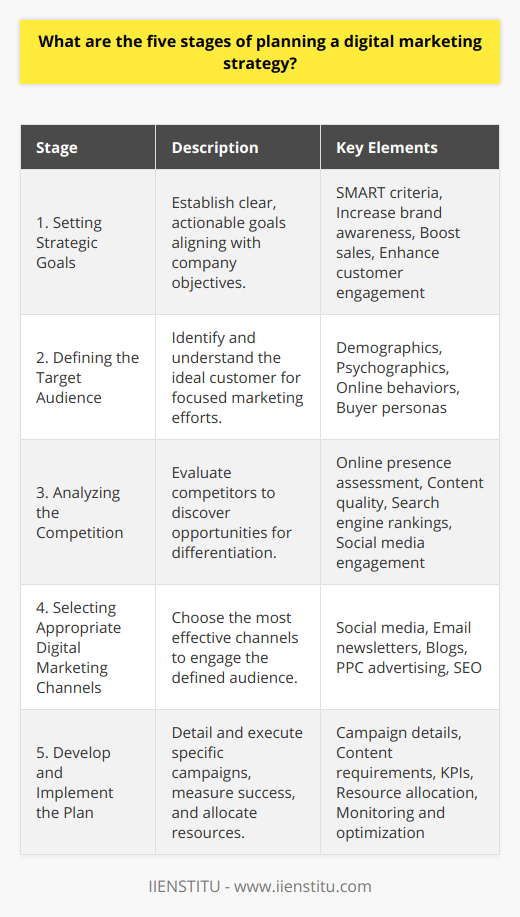
What are your top three digital marketing strategies to attract clients?
Subheading: Utilizing Social Media Channels
The first strategy, often underestimated, revolves around the productive use of social media. Active social media presence exposes the product to a worldwide audience. It also allows direct interaction with potential customers, increasing brand credibility. For this, social marketers need to acquaint themselves with changing algorithms and customer behavior to ensure effective communication of products or services.
Subheading: Engaging in Content Marketing
The second strategy pertains to content marketing, a valuable digital marketing strategy that uses informative, compelling content to attract and engage users. High-quality content, which is both relevant and valuable, plays a critical role in capturing consumer attention. Through blogs, articles, infographics, and videos, marketers can effectively communicate brand values while indirectly promoting their products or services.
Subheading: Implementing SEO Techniques
Lastly, the incorporation of search engine optimization (SEO) techniques aids in improving web visibility. The main goal of SEO is to rank the website higher on search engine results pages (SERPs), thus drawing more potential clients. Employing relevant keyword research and optimizing content with technical SEO can effectively attract organic traffic to the site. High-quality backlinks increase website authority and improve ranking, hence increasing visibility and reach to potential clients.
In conclusion, effective digital marketing strategies encompass the integration of social media channel utilization, engaging content creation, and strategic SEO techniques. These strategies operate synergistically to improve online visibility, thereby influencing consumer decision processes and attracting potential clients.

How long does it take to create a comprehensive digital marketing strategy?
Creation Timeline of a Comprehensive Digital Marketing Strategy
Creating a comprehensive digital marketing strategy is not an overnight task. The time spent on strategy planning typically depends on numerous intertwined factors. It could take anywhere from one month to six months or more to develop a thorough and effective strategy.
Initial Research and Analysis
The first step involves conducting in-depth market research, competitor analysis, and identifying target audience behavior. This initial phase may consume anywhere between two weeks to a month, depending on the complexity of the business model and market conditions.
Setting Goals and Channels
Post-research, planning goals, selecting appropriate channels and deciding on the marketing mix follows. This process might take a few weeks, as the objectives should align with broader business goals.
Content Development and Curation
The most time-consuming aspect is often content development and curation, which entails designing appealing and engaging material for different platforms. This process can take a month or more based on the frequency and volume of required content.
Testing and Revision
Furthermore, testing and revising the strategy is also crucial. A minimum one month is needed for testing to ensure the implemented strategy works effectively in achieving business objectives.
Ongoing Evaluation
Lastly, there's the ongoing effort of tracking, analyzing, and adjusting strategies in response to data and performance metrics. This process takes place continuously after initial implementation. In summary, creating a comprehensive digital marketing strategy is a complex and time-consuming process but utterly valuable for overall business success.

